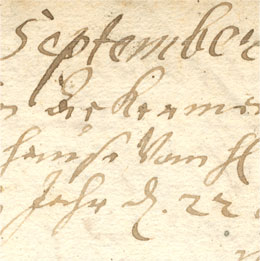The Rapla Church pulpit
The pulpit that was transferred from Rapla’s old medieval church to the new church, which was completed at the start of the 20th century, was completed in 1700 with the participation of Christian Ackermann. Later adaptations were made in order to fit the conditions in the new church.
Who commissioned the pulpit for Rapla’s old medieval church?
Matthias von Stauden, the owner of Lelle and Linnape manors, commissioned the Rapla Church pulpit, which was completed in 1700, in memory of his wife Anna Dorothea von Richter, who died in 1682, and in honour of her and his second wife Johanna Katharina von Taube. The new pulpit was commissioned for Rapla’s old medieval church. As was traditional, the coats-of-arms of the nobles who were either directly or indirectly associated with the pulpit’s donation were mounted on the sounding board.
The pulpit was originally attached to the church’s chancel arch and situated in such a way that the staircase faced the congregation. Sermons given from the pulpit could also be observed from the sanctuary, where pews were situated for the more important members of the congregation.
What does the stylistic analysis of the pulpit indicate?
In 1943, the art historian Sten Karling attributed the Rapla pulpit to Ackermann. A new stylistic analysis of its figures carried out in the course of studies of the master’s oeuvre that spanned from 2016 to 2020 indicates that Ackermann did not carve them alone.
The types and cutting style of the evangelists and of Christ as Salvator Mundi depicted on the pulpit’s corpus, and of the putto corbel with spread wings that crowns the door portal resemble the master’s previous works, yet the putto corbels of the corpus and part of the floral ornamentation are different. The pelican with three chicks that crowns the pulpit’s sounding board differs from the pelicans of the retables in the churches at Vigala and Hageri as well as the pelican of the Karuse Church pulpit, all of which are associated with Ackermann’s workshop.
The use and treatment of the ornamentation are also different compared to Ackermann’s previous works. Foliage ornamentation was not used to decorate the cornice of any other pulpit’s corpus that was completed with Ackermann’s participation. No other pulpit has ornamental reliefs instead of nameplates for its figures, and only foliage, acanthus, and floral ornamentation on its stair balustrade. No other pulpit has a corpus that is supported by a column decorated with running vine, or tendril, ornamentation.
Thus, the hypothesis emerges that the Rapla Church pulpit was fashioned in two different workshops: the figures of Christ and the evangelists mounted on the corpus and the putto corbel mounted above the door portal were made in Ackermann’s workshop, but some other master fashioned the pulpit’s corpus and sounding board together with the accompanying décor.
A new building in the round arch style inspired by the Romanesque style was built in 1901 in Rapla in place of its medieval church. The old church’s pulpit was taken down from its location and installed in the new church. Only the pulpit’s original door portal was done away with. The Neo-Baroque style was gaining popularity by the time that the new Rapla Church was nearing completion, for which reason the style of Ackermann’s pulpit also fit in with the new church building.
